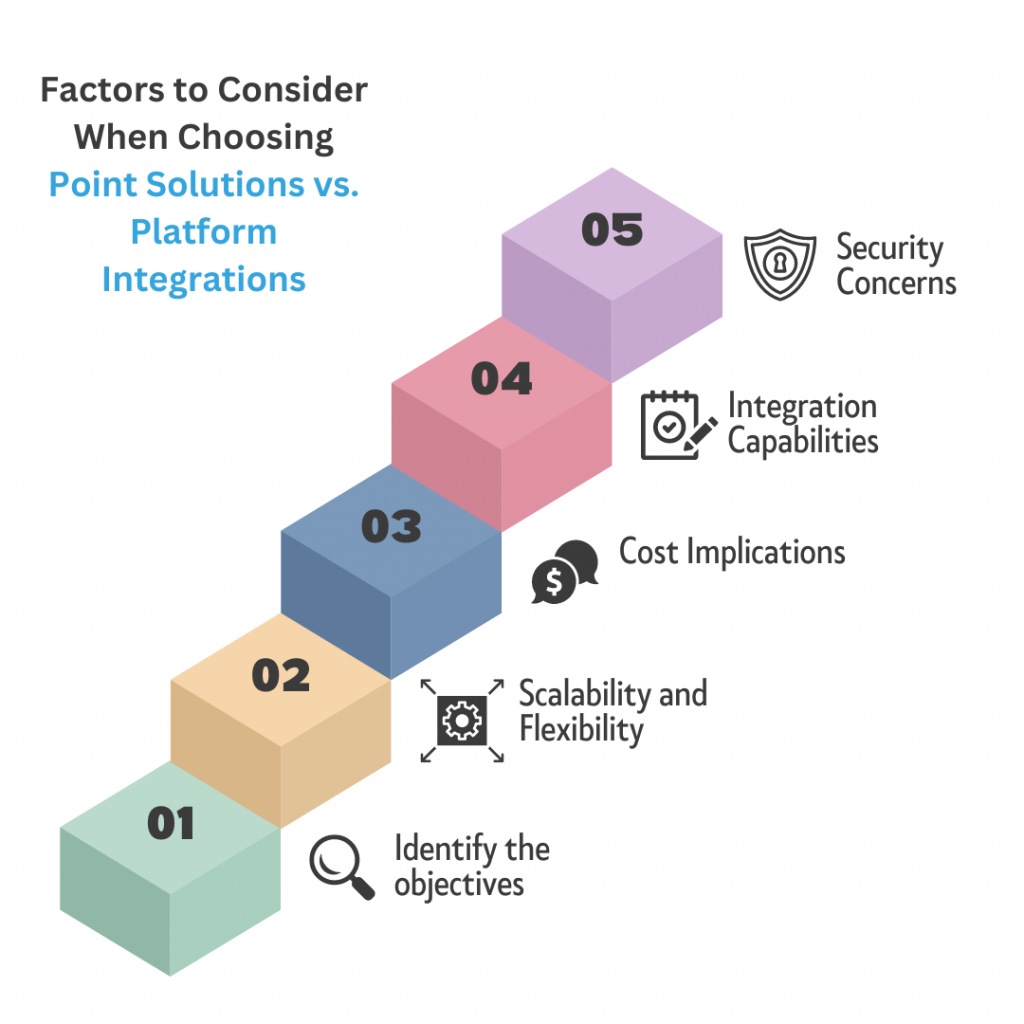Choosing the right technology solution is essential to success in today’s fast-paced business environment. Whether you’re a small startup or a large enterprise, the decision to adopt a point solution or integrate with a platform solution can have a significant impact on your operations and bottom line. Let’s dive into the nitty gritty of these options, and make sure you have all the information you need to make an informed decision.
What is Platform Solutions?
At its core, a platform solution is an infrastructure technology that supports the various applications, processes, or technologies that are built on top of it. Think of it as the digital equivalent of the physical foundation of the building; Just as a strong foundation supports strategy, a strong platform solution supports a business’ digital operations. These platforms are designed to be highly flexible, allowing enterprises to integrate a variety of tools, applications and services to create custom ecosystems that meet their unique needs
In today’s fast-paced digital world, the flexibility and scalability that platform solutions offer has become essential. Whether you’re a small startup or a large business, the ability to quickly optimize and scale your technology platform is essential to staying competitive. Platform solutions provide this flexibility, and enable enterprises to add or change functionality quickly, without compromising their core operations.
By choosing a platform solution, businesses can leverage a collaborative ecosystem that promotes efficiency, productivity and innovation. It’s about creating technology that can grow and evolve with your business, ensuring you’re always ready to meet the challenges and opportunities of the digital age.
Must Read: 10 Reasons Why Platform Solutions Are a Better Choice than Point Solutions
Factors to Consider When Choosing Point Solutions vs. Platform Integrations
It is necessary to conduct a thorough analysis of both the present and future requirements of your company before making a decision between platform integrations and point solutions. Take into consideration the following important aspects:
Business Needs and Goals: Start by evaluating both your short-term and long-term business goals. This is the first step in determining your business needs and goals. In the event that you require specialized functionality for various departments that do not share a significant amount of overlap, point solutions may be an excellent choice for you. On the other hand, if you want to improve collaboration between departments and streamline operations, then integrating a platform can be more useful for you.
Capacity for Scalability and Flexibility: Examine the rate at which you intend to expand and the ways in which your requirements may evolve. Platform solutions often provide greater scalability and flexibility, enabling you to add or adjust capabilities as your organization develops without the need for several additional integrations. This is because platform solutions are designed to be scalable and flexible.
Cost Implications: Consider the implications of cost by calculating the total cost of ownership, which should include the initial setup, subscription fees, training, and continuing maintenance costs. On the other hand, point solutions may have lower initial costs, but when more tools are added, they may become more expensive and more difficult to use. Although there is a possibility that platform integrations would demand a bigger initial investment, they tend to deliver cost savings in the long term.
Integration Capabilities: It is of the utmost importance to take into consideration how well the new technology will connect with the systems that you already have in place. Integration that is seamless can improve the flow of data and operational efficiency, whereas integration that is not seamless can result in silos and inefficiencies.
Security Concerns: In light of the growing number of cyberattacks, it is important to analyze the security features of both of the available choices. It is possible that platform solutions will provide complete security procedures across all functionalities; nevertheless, it may be more difficult to manage security across various point solutions.
By carefully assessing all of these factors against your company’s unique demands and resources, you can make an informed decision that promotes operational efficiency and growth.
Must Read: What Are The Most Trending Apps In USA- Top 40
Point Solutions vs. Platform Integrations: An Overview
When faced with a particular problem, it’s tempting to quickly look for a solution—a solution that solves just that, no more, no less. This is where point solutions come into play. They are like special tools in a toolbox, each designed for a specific task. For example, you might use a point solution for email marketing, another for customer relationship management (CRM), and another for inventory management. While each tool excels in its specific domain, managing multipoint solutions can become complicated over time, creating data silos and integration challenges
In other words, platform modifications represent a general approach. Imagine multiple tools that, instead of carrying a set of one-off tools, offer an integrated set of tools designed to work together seamlessly. This approach not only streamlines data flow and collaboration but also ensures that all parts of the assembled business technology communicate effectively, increasing overall productivity and efficiency.
Choosing a point solution and platform integration depends on many factors, including the size of your business, your specific needs, and your long-term growth plans.
Advantages and Disadvantages of Point Solutions
Advantages of Point Solutions
- Specialization: Point solutions offer deep functionality and are often best-in-class for their specific purpose, providing advanced features that specialized users need.
- Quick Implementation: They can be quicker to implement and adopt, as they focus on solving a singular issue without the complexity of broader system integrations.
- Flexibility: Businesses can select the best point solution available for each specific need, potentially leading to a best-of-breed technology stack.
Disadvantages of Point Solutions
- Integration Challenges: Managing multiple point solutions can lead to data silos and integration headaches, as ensuring smooth data flow between disparate systems can be complex.
- Increased Overhead: Each solution may come with its own subscription fee, training requirements, and support teams, leading to higher operational costs.
- Inconsistency: Varying user interfaces and experiences across multiple point solutions can lead to a steeper learning curve and decreased efficiency.
Advantages and Disadvantages of Platform Integrations
Advantages of Platform Integrations
- Unified System: A single, cohesive platform reduces the complexity of managing multiple systems, streamlining operations and data management.
- Scalability: Platform solutions are designed to grow with your business, making it easier to add or adjust functionalities as needed without significant overhauls.
- Consistency: A unified platform provides a consistent user experience and learning curve, potentially increasing adoption rates and productivity.
Disadvantages of Platform Integrations
- Flexibility Limitations: While offering a broad range of functionalities, a single platform may not offer the depth of features in specific areas compared to specialized point solutions.
- Investment: Implementing a comprehensive platform solution can require a significant upfront investment in terms of time, resources, and finances.
- Vendor Lock-in: Dependence on a single provider for your entire technology stack can pose risks if the provider fails to innovate or if pricing models change unfavorably.
Must see: Best Low-Code Platforms to Build Applications in 2024
Steps for Making the Right Choice for Your Business
The decision between point solutions and platform integrations is not one-size-fits-all; it hinges on a nuanced understanding of your business’s unique requirements, goals, and the technological landscape. Here’s a pragmatic approach to making the right choice:
Step 1. Evaluate Your Business Needs
Begin with a thorough analysis of your current technological capabilities and gaps. Understand the specific problems you’re trying to solve and how they align with your business objectives.
Step 2. Consult Stakeholders
Engage with stakeholders across departments to gather insights on their needs, preferences, and pain points. This will ensure the chosen solution addresses the broader business needs and not just those of a single team.
Step 3. Consider Future Growth
Reflect on your business’s growth trajectory and how your technological needs might evolve. A solution that fits your needs today should also be scalable to accommodate future growth without extensive overhauls.
Step 4. Assess Integration and Compatibility
Ensure the solution you choose can integrate smoothly with your existing technology stack. This can prevent data silos and facilitate a more cohesive operational flow.
Step 5. Conduct a Cost-Benefit Analysis
Weigh the costs of implementation, training, and maintenance against the expected benefits in efficiency, productivity, and scalability. This analysis should guide your decision toward the option that offers the best value over time.
Step 6. Explore Vendor Support and Community
A strong support network, both from the vendor and its user community, can be invaluable for troubleshooting, learning, and optimizing the use of your chosen solution.
Step 7. Pilot solution of your choice
Consider conducting a pilot program with your chosen solution before fully committing to it. This allows you to test its effectiveness in your environment and make informed decisions based on actual usage.
Making the right choice requires careful consideration of these steps, aligning your decision with your immediate needs and long-term business strategy.
Final Words
Figuring out tech for your business can be tricky, especially when it comes to point solutions vs platform integration. We’ve gone over the factors, the pros and cons, and laid out what you need to think about before deciding. Maybe you want highly specialized point solutions or you prefer a smooth-running integrated platform. The big question is – does it fit with your business aims, growth plans, and workflow?
- Point solutions give thorough service in their set area, yet bringing them together can be tricky.
- With Platform integrations, it’s like one big happy family, boosting smooth operations and room to grow.
- Thinking about factors like your business targets, how quickly you want to expand, spends, and safety is super important when making choices.






Pingback: 10 Reasons Why Platform Solutions Are a Better Choice than Point Solutions
Pingback: Shortlinkstop.online: The Wonders of Link Management
Pingback: How Frables Epix Net is Changing Digital Entertainment 2024
Pingback: Leomorg: Digital Creativity and Cultural Exploration
Pingback: The Role of Trendzguruji.me Awareness in Shaping Digital Trends